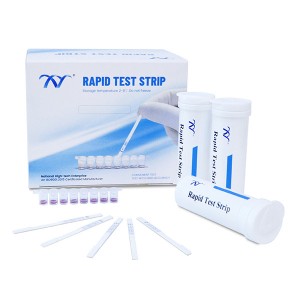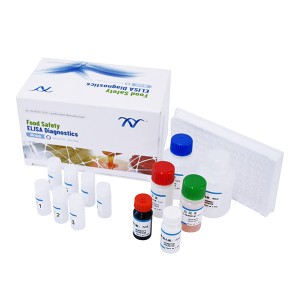Food safety is a critical concern in global supply chains. Residues such as antibiotics in dairy products or excessive pesticides in fruits and vegetables can trigger international trade disputes or consumer health risks. While traditional lab testing methods (e.g., HPLC, mass spectrometry) offer precision, their high costs, lengthy turnaround times, and operational complexity often fail to meet the real-time demands of globalized businesses. Rapid test strips and enzyme-linked immunosorbent assay (ELISA) kits have emerged as cost-effective, flexible solutions for food manufacturers, exporters, and regulatory bodies. This article explores their applications in global food safety, focusing on milk antibiotic detection and pesticide residue analysis.
I. Technical Comparison: Speed, Cost, and Accuracy
1. Rapid Test Strips: On-Site Screening Champion
Rapid test strips utilize immunochromatographic technology to generate visual results (e.g., colored bands) within 5–15 minutes via antigen-antibody reactions. Key advantages include:
Ultra-low cost: At $1–5 per test, they are ideal for high-frequency screening. For instance, dairy plants use strips to daily screen raw milk for beta-lactam antibiotics (e.g., penicillin), preventing contaminated batches from entering production.

Equipment-free operation: Simple protocols enable frontline workers to perform tests after minimal training. Global agricultural exporters deploy strips at ports to check pesticide residues (e.g., chlorpyrifos, chlorothalonil) against import standards like EU Maximum Residue Limits (MRLs).
However, strips have limitations: sensitivity (70–90%) and semi-quantitative results may miss trace residues. For example, sulfonamide antibiotics in milk near the EU threshold (10 μg/kg) risk false negatives.

2. ELISA Kits: Precision Meets Throughput
ELISA quantifies targets via enzyme-substrate reactions, achieving pg/mL-level sensitivity and batch processing (e.g., 96-well plates):
High precision and quantitation: Crucial for regulatory compliance. The U.S. FDA mandates tetracycline antibiotics in milk not exceed 300 μg/kg; ELISA ensures accurate measurement to avoid trade penalties.
Mid-range cost efficiency: At $5–20 per test, ELISA require samicroplate reader (3,000–$8,000). For medium-sized enterprises processing 50–200 daily samples, long-term costs undercut outsourcing to labs.
Yet, ELISA demands 2–4 hours per run and standardized protocols, necessitating skilled personnel.
II. Strategic Selection in Global Contexts
Three Scenarios Favoring Rapid Test Strips
Upstream Supply Chain Screening
Strips swiftly intercept high-risk raw materials. Brazilian soybean exporters prescreen glyphosate residues before shipment, sending only negative batches for lab confirmation — reducing testing costs by over 30%.
Cross-Border Compliance Checks
Customs or auditors use strips at ports or warehouses to avoid cargo delays. Vietnamese shrimp exporters test nitrofuran metabolites with strips to comply with Japan’s Positive List System.
Resource-Limited Regions
Small farms or processors in developing nations rely on strips for risk control. African dairy cooperatives screen milk for antibiotics onsite, referring positive samples to regional labs.
Three Scenarios Favoring ELISA Kits
Export Certification and Legal Disputes
ELISA’s precision and traceability are vital for legal compliance. Indian spice exporters provide ELISA-based aflatoxin B1 reports (EU threshold: 2 μg/kg) to meet EC No. 1881/2006.
Medium-to-High Throughput Demands
Large-scale manufacturers or central labs benefit from ELISA’s batch processing. A Dutch dairy firm tests 500+ milk batches daily for beta-lactams and tetracyclines within 4 hours.
R&D and Quality Control
ELISA’s quantitative data supports long-term monitoring. Chilean wineries track seasonal carbendazim pesticide trends to optimize vineyard practices.
III. Global Cost-Benefit Insights
Hidden Costs and Risk Mitigation
False negatives from strips may lead to recalls (e.g., France’s 2021 infant formula salmonella incident), while ELISA’s equipment costs diminish with scale. Multinationals adopt “strip screening + ELISA confirmation” to balance cost and compliance.
Technological Convergence
Nanomaterial-enhanced strips: Gold nanoparticle-labeled strips detect antibiotics at 1 μg/kg, nearing ELISA sensitivity.
Portable ELISA readers: Compact devices enable onsite testing below $1,500, narrowing the applicability gap.
IV. Conclusion: Building a Global Detection Network
To navigate diverse international standards (e.g., China’s GB 2763, U.S. EPA, EU EC), food businesses must dynamically select tools:
Rapid strips: Prioritize speed for upstream screening, emergencies, or low-resource settings.
ELISA kits: Deliver precision for certification, mid-high throughput, and data-driven decisions.
Global enterprises should adopt a tiered strategy: For example, Indian dairy cooperatives use strips for initial antibiotic screening, ELISA for regional confirmation, and accredited labs (e.g., SGS, Eurofins) for disputed samples. This “detection pyramid” balances cost efficiency with trade risk reduction, fortifying the global food safety ecosystem.
Post time: May-15-2025

